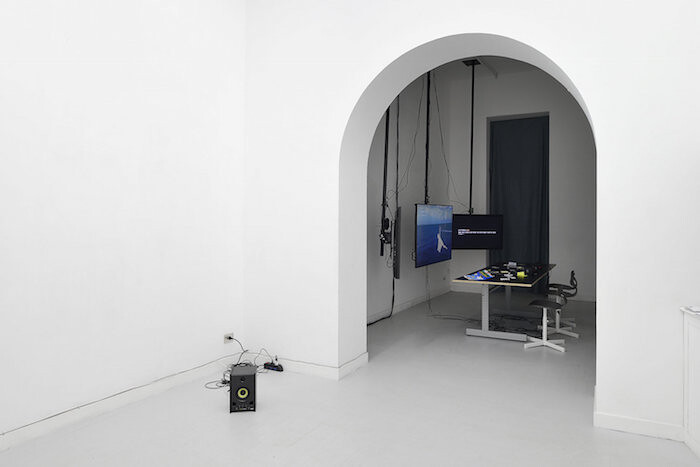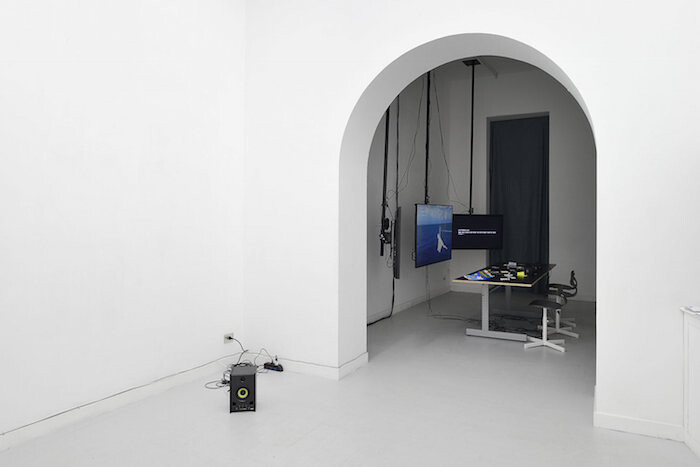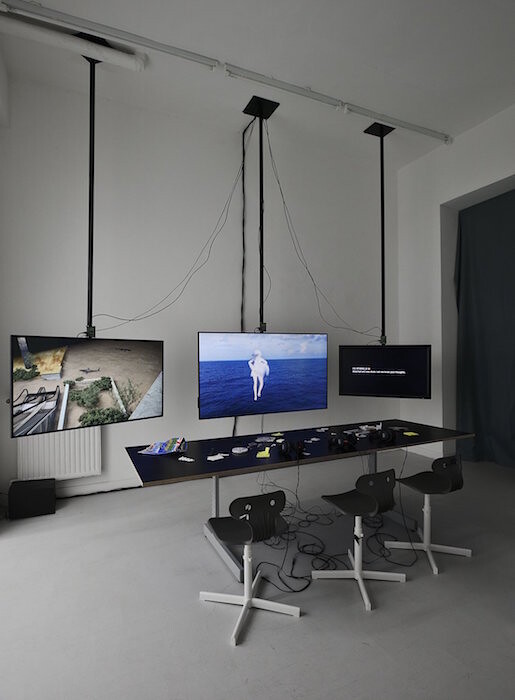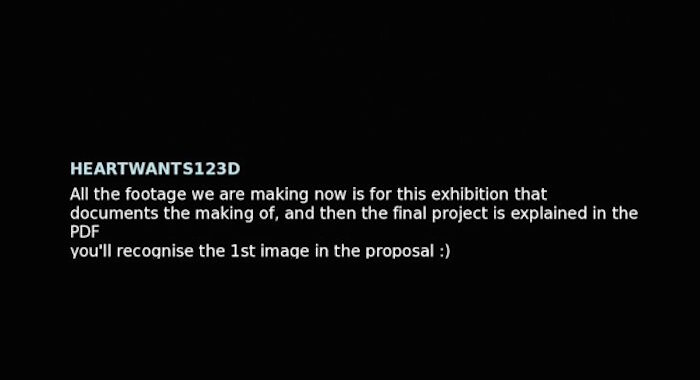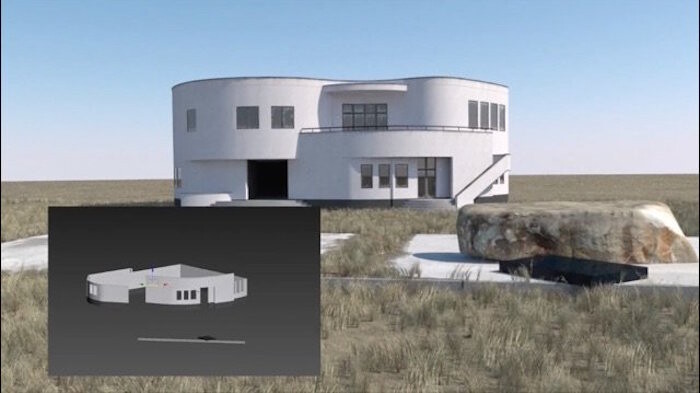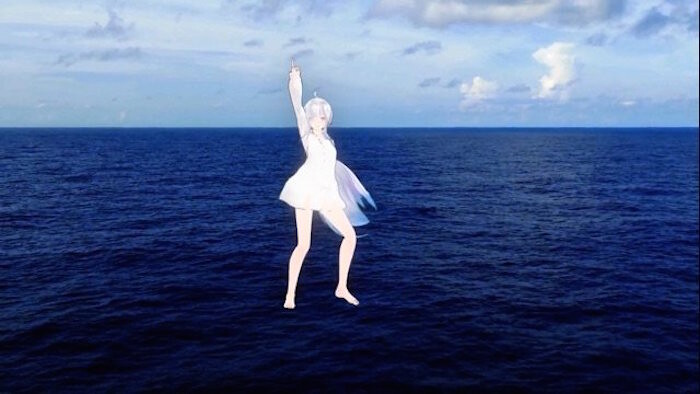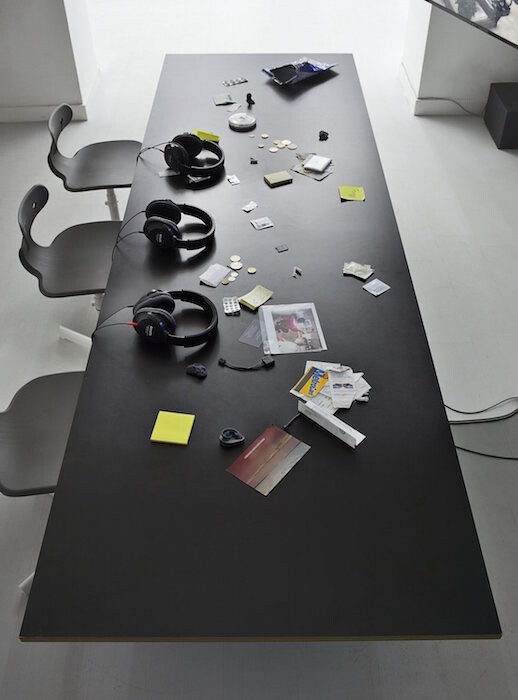— Thank you for the kind words
— :-)
— And thank you for the bonus
This telling fragment of chat, extracted from Cécile B. Evans’s Working on What the Heart Wants (2016), informed my experience of this multichannel video installation, which records a group of humans interacting with and through machines, across timelines and deadlines, to collaborate on a visual project involving the construction of a new so-called person called HYPER; “a system that is a woman,” writes the artist on her website. The users’ exchanges involve technical matters relating to CGI and rendering, along with codified online expressions of feelings (emoticons and adjectives conveying happiness, friendliness, satisfaction), as well as undisclosed amounts of money. Wages and invoices, often popping up in the live-streamed conversations, act as reminders of the bare fact that, although invisible and anonymous, the bodies operating behind the machinic screens are real. Their individual abilities are purposefully mined and rewarded in accordance with their performance. In postindustrial times, etiquette and authenticity are conditioned by the prompt delivery of “services.” And art proves no exception: by “disclosing” her supposedly daily progresses as fully visible and shareable material, Evans maximizes the emotionally charged but otherwise dead time of production. She makes it profitable.
The installation on view at Lira (an Italianate anagram of Layr, i.e. Emanuel Layr, whose Viennese gallery has recently doubled in Rome, with a small space just off Piazza di Spagna) is, very literally, a work in progress. Like its previous version presented in Paris at the Musée d’Art Moderne de la Ville de Paris, as part of the group show “Co-Workers – Network as Artist” (2015–16), the installation illustrates the making of a new work, titled What The Heart Wants, before its official debut at the 9th Berlin Biennale later this week. Time’s almost up, and the countdown accelerates; the number of co-workers keeps growing. The artist reaches out for help: she outsources—Are you in Teheran or Istanbul? (a little flag identifies the nationalities of the freelancers involved)—assigns tasks, and masters decision making in a display of fluctuating consciousness as captivating as the seductive images it helps to build, animate, and modify. HEARTWANTS123D, one of the artist’s multiple nicknames, is kind, she is present, she is super excited, she is always on. Her answers are clear and considerate. She definitely knows how to communicate: like AGNES, the teenage spam bot Evans created to interact with the users of the Serpentine Gallery’s website by sharing emotions and information, she is “affective.” Isn’t she?
Moving from one screen to the other, the gaze falls on the table right below and starts noticing coins, an empty medicine blister, lens-wipes, a pill container, a bag of crisps, train tickets, metro cards, 3D-printed models of sculptures, Post-it notes, receipts. The table and chairs mirror those in Evans’s studio, so that viewers end up watching a reconstruction of a reality virtually happening elsewhere by means of their in-built oculi, their eyes. As if they were there too, in absentia. Well, maybe. Anyway, they are made to listen—full blast, thanks to a couple of loudspeakers installed at the entrance—to the playlist including all the tracks Evans’s team has been listening to while working on the video. With headphones on, instead, it’s the video’s immersive soundtrack that draws viewers in.
Some of the characters featured on the screens have been with Evans for years. Take HAKU, for instance, dancing in front of the blue waves of the sea, with her cerulean free-floating hair, who also appeared in Evans’s Softness in 2015: she’s a “humanoid persona” similar to Hatsune Miku, the Vocaloid singer (developed by the Japanese company Crypton Future Media) who performed during Lady Gaga’s last tour in Japan. Her pubescent body, kawaii and sexy, dancing to the users’ music, moving to meet their clicks, made her an instant commercial success upon release almost a decade ago. The same beautiful jellyfish fluctuating in Working on What the Heart Wants also appeared in Softness and in Evans’s 2014 video Hyperlinks or It Didn’t Happen, as did the sharks, now swimming in the shallow waters of a flooded shopping mall. There are also two romantic lovers, hugging and kissing. These figures are alternately backgrounded by scenes of wilderness, a white villa (Saltzman House, designed by Richard Meier in East Hampton in 1967), and the dark interiors of Mike Tyson’s apartment, with “Mis Hu” tagged on a mirror. Constant fragmentation does not allow any comprehension of the plot, and forces viewers, instead, to focus on the process of its generation.
Here the main actor is the faceless HYPER, dressed in a black bodysuit. Her body defines her as female, but it’s precisely her “physical” definition that entails the most work for the artist and her team. Her boobs, thighs, stomach, waistline, and complexion need to be adjusted, over and over again, to look more muscular, more masculine, less Barbie, more Beyoncé, less Beyoncé, a tad Lara Croft, with combat boots. HYPER is modeled after celeb images, which the artist uses to describe the “she” she has in mind. In the absence of facial features and expression—the main source for decryption and caption of human non-verbal communication—body language is key. Evans objectifies it. The look of HYPER’s plaited hair becomes crucial—a combination of Nicole Kidman and Emma Stone, she explains. After each restyling, the figure revolves on her axis, like a mannequin on a turntable, under collective scrutiny. Like the nondescript actress of Cindy Sherman’s Untitled Film Stills (1977–80), she embodies contemporary stereotypes and standards. To paraphrase Simone de Beauvoir’s famous line, one could say that HYPER is not born a (post-internet) woman, but becomes one.
Feminism has historically proven how subversive and empowering diaries can be, both in words and images, as instruments of self-awareness. Think, for instance, of Eleanor Antin’s Carving: A Traditional Sculpture (1972), a record of 37 days of diet, where the artist’s naked body and its formal mutations are photographed from all sides. By practicing an uneasy “autobiography in public” (to quote from Virginia Woolf’s own diary, written in 1938), Evans questions the collective creation, social iconography, and more or less accountable biometrics of our “gendered selves.”1 New technologies help her to update very old issues. Since masculinity and femininity are cultural constructions, how is the digital evolution of identities redesigning their boundaries? Evans’s fluid images measure our response to gender stereotyping, as well as her deconstruction of it, prompting us to consider how ready we are to buy in.
Virginia Woolf, The Diary of Virginia Woolf, Volume 5, 1936-41, ed. by Anne Olivier Bell and Andrew McNeillie (London: Chatto, 1984), 141.
